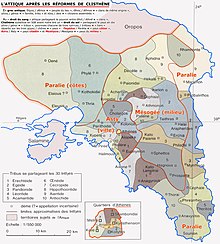
Alopece (Ancient Greek: Ἀλωπεκή, romanized: Alopeke), also spelt as Alopecae, was an asty-deme of the city of Athens,[1] but located exterior to the city wall of Athens.[2][3] Alopece belonged to the tribal group (phyle) of Antiochis.[4][5][6] It was situated only eleven or twelve stadia from the city,[7] and not far from Cynosarges.[8] It possessed a temple of Aphrodite,[9] and also apparently one of Hermaphroditus.[10]
Burial site
[edit]The tomb of Anchimolius is near the temple of Hercules at Cynosarges, within Alopece.[11][12]
Natives
[edit]Lysimachus II – son of Aristides I, Aristides II – son of Lysimachus II, Thucydides II – son of Melesias II, Melesias II – son of Thucydides I, Socrates, son of Sophroniscus (of the tribe of Alopece[13]).[14]
Critobolus (c.5/4th century BC) son of Crito (also of the deme), both followers of Socrates.[15]
Hermogenes (c.445 to after 392 BC), was credited by Xenophon as being the source of much information about the latter part Socrates' life. In addition he is a participant in Cratylus, and is mentioned in Phaedo.[16]
Megacles son of Hippocrates, Cleisthenes' nephew and leader of the Alcmaeonids. Also Callias, son of Cratias.[17][18]
Megacles V, son of Megacles IV. Melesius, a famous wrestler, father of Thucydides I.[19]
Satyrus, brother of Lacadaemonius, was arbitrator at a trial involving a dispute on the release of an enslaved woman, who had stolen from her owner prior to her release.[20][21]
Property
[edit]Timarchus had a farm there (97), eleven or twelve stades from the city wall (99).[2]
Records dating from the years 367 to 366, show a person from Lakiadai had acquired property in this deme, which was previously owned by a person affiliated with Xypetē.[22]
See also
[edit]References
[edit]- ^ JG Cooper – The Life of Socrates R. Dodsley, 1750 [Retrieved – 21 March 2015]
- ^ a b Aeschines (1 January 2010). Against Timarchus. translation and commentary by C. Carey, Professor of Greek at University College London c.2010. University of Texas Press, 1 January 2010. ISBN 9780292782778. Retrieved 22 March 2015.
- ^ The Editors of Encyclopædia Britannica - Aeschines [Retrieved 22 March 2015]
- ^ Herodotus (translated by Reverend W.Beloe) – (p.263) T. Wardle., 1839 (489 pages) copy from the University of Virginia [Retrieved 30 May 2015]
- ^ Lund University. Digital Atlas of the Roman Empire.
- ^ Richard Talbert, ed. (2000). Barrington Atlas of the Greek and Roman World. Princeton University Press. p. 59, and directory notes accompanying. ISBN 978-0-691-03169-9.
- ^ Aesch. c. Timarch. p. 119, ed. Reiske
- ^ Herodotus. Histories. Vol. 5.63.
- ^ Böckh, Inscr. n. 395
- ^ Alciphr. Ep. 3.37.
- ^ Herodotus, I Taylor – Herodotus. Translated from the Greek for the Use of General Readers; with Short Explanatory Notes. By Isaac Taylor 1829 (Original from The British Library, Digitized 9 December 2014) [Retrieved 21 March 2015]
- ^ Herodotus translated by Rev.W.Beloe – Volume 2 (p.188) P.P. Berresford, 1828 (Original from the University of Michigan, Digitized 10 August 2007) [Retrieved 21 March 2015]
- ^ Encyclopædia Britannica: or, A dictionary of arts and sciences, compiled by a society of gentlemen in Scotland [ed. by W. Smellie]. Suppl. to the 3rd. ed., by G. Gleig (p.460) published 1810 & 1823 (Original from Oxford University, Digitized 24 May 2007) [Retrieved 22 March 2015]
- ^ Debra Nails (Professor of Philosophy, Michigan State University.)- The People of Plato (p.312) Hackett Publishing ISBN 1603844031 [Retrieved 21 March 2015]
- ^ T Curnow (c.2006 Senior Lecturer: Division of Religion and Philosophy, St Martin's College, Lancaster) – The Philosophers of the Ancient World: An A-Z Guide (p.88) A&C Black, 22 June 2006 ISBN 0715634976 [Retrieved 21 March 2015]
- ^ A Preus (Distinguished Teaching Professor at Binghamton University) – Historical Dictionary of Ancient Greek Philosophy (p.189) Rowman & Littlefield, 12 February 2015 ISBN 1442246391 [Retrieved 21 March 2015]
- ^ T Buckley (25 February 2010). Aspects of Greek History 750–323BC: A Source-Based Approach. Routledge, 25 February 2010. 560 pages. ISBN 9781135281847. Retrieved 22 March 2015.
- ^ verified <Hippocrates> at Aristotle (translated by FG Kenyon- The Athenian Constitution (Part 22) Archived 2 April 2015 at the Wayback Machine MindFull Media , 28 January 2015 (163 pages) [Retrieved 2015-3-22]
- ^ D Nails – The People of Plato p.340 [Retrieved 22 March 2015]
- ^ Wolpert, Andrew; Kapparis, Konstantinos – Legal Speeches of Democratic Athens: Sources for Athenian History p.204 Hackett Publishing, 9 September 2011 ISBN 1603846166 Retrieved 7 February 2017
- ^ Johnstone, Steven – A History of Trust in Ancient Greece p.15-16 University of Chicago Press, 1 October 2011 ISBN 0226405095 Retrieved 7 February 2017
- ^ E. Cohen (10 January 2009). The Athenian Nation (p.125). Princeton University Press, 10 January 2009 (reprint) 272 pages. ISBN 978-1400824663. Retrieved 30 May 2015.
![]() This article incorporates text from a publication now in the public domain: Smith, William, ed. (1854–1857). "Attica". Dictionary of Greek and Roman Geography. London: John Murray.
This article incorporates text from a publication now in the public domain: Smith, William, ed. (1854–1857). "Attica". Dictionary of Greek and Roman Geography. London: John Murray.
External links
[edit]- Dictionary of Greek and Roman Geography (1854) William Smith, LLD, Ed.